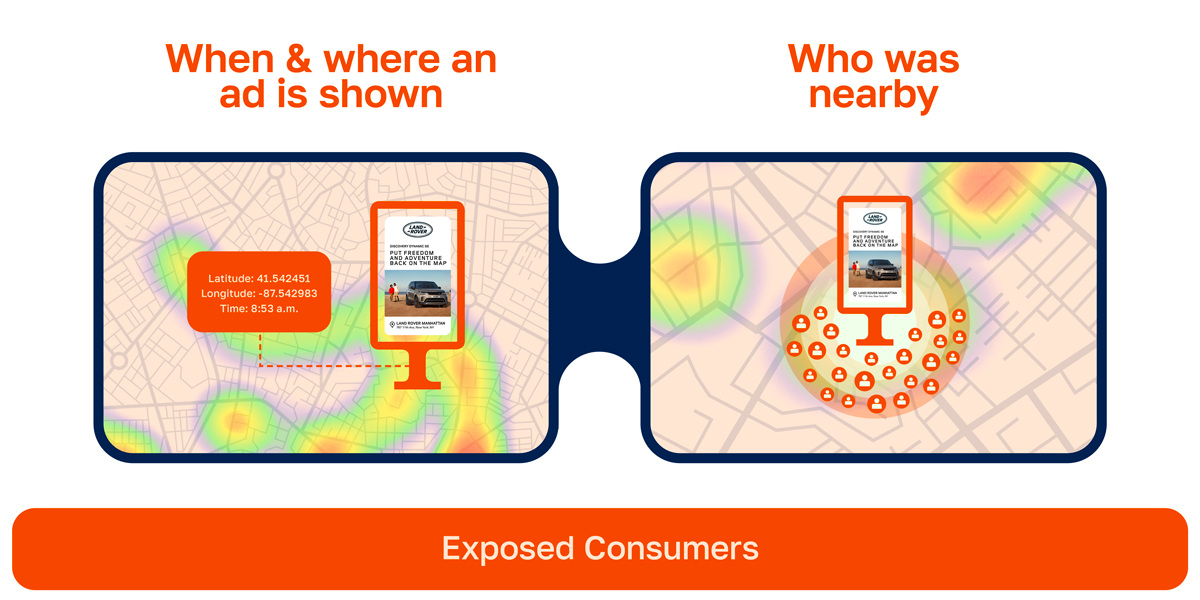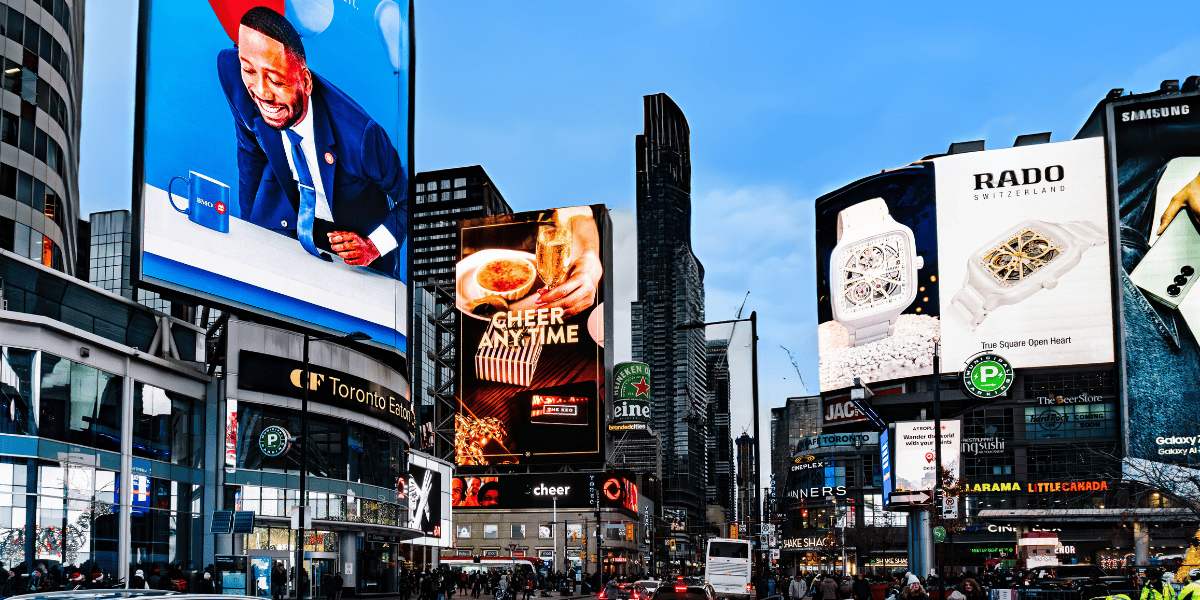
Marketers are no strangers to measuring the effectiveness of their campaigns. But what if I told you that with the help of programmatic technology, measurement within the out-of-home industry is easier than ever before? And, with this newfound power — you can confidently and conveniently measure your entire campaign from top to bottom of the marketing funnel. Let’s look at how measurement is used in the digital out-of-home (DOOH) industry today.
Table of contents
1. How is DOOH advertising measured?
2. The best measurement solutions for DOOH
2.1 Brand health study
2.2 Foot traffic study
2.3 Web conversions & TV tune-in metrics
2.4 Device ID passback
3. What’s next for DOOH measurement
How is DOOH advertising measured?
For the past decade, advertisers have been using location-based data to better understand their consumers and create more targeted campaigns— leaving them wondering how to measure DOOH advertising. In DOOH, the most reliable way to measure advertising effectiveness is to focus on verified exposure—knowing exactly who saw your ad and what actions they took afterward. Essentially, to measure the effectiveness of an advertisement on digital out-of-home media, brands need to assess the impact of their campaign among individuals who have seen their DOOH media versus those who have not. Once you know who saw the ad and who didn’t, you can compare their actions to see how the ad made a difference in the real world.
To sum it up, measuring the success of your DOOH campaign requires two things:
- Knowing when and where your ad played and who was there to see it, which is also known as exposure.
- Understanding how that exposure drove real-world actions.

The best measurement solutions for DOOH
Despite the power of out-of-home media, the channel historically has been considered a bit of a wild card for marketers that want precise result metrics. The mass medium is one to many, diverse and the advertising effectiveness too hard to measure. In other words, tracking DOOH advertising campaigns was too difficult. But times have changed!
Marketers can now measure the impact of out-of-home advertising using key performance indicators (KPIs) based on location data and advanced analytics. While OOH has traditionally been seen as an awareness driver, today’s leading brands are using it to drive a variety of marketing results. Let’s take a look at the best measurement solutions used for DOOH campaigns today.

Brand health study
Focusing on the top of the funnel, brand studies are often used to understand campaign effectiveness on overall brand metrics including awareness, consideration, intent (purchase, sign-up, travel, etc.), favorability and recommendation.
Vistar’s brand health studies are conducted in partnership with MFour, a leading mobile survey platform that enables precise audience targeting and real-time feedback.
Brand studies are great for marketers launching campaigns around:
- General branding or rebranding efforts
- New brand or product launches
- Competitive awareness and conquesting
- Loyalty programs
- Intent or action-driving measures (tune-in, visits, downloads, etc.)
Foot traffic study
The most reliable way to measure the advertising effectiveness of DOOH in driving in-store visits is through a foot traffic study. Marketers from a variety of verticals — retail to QSR, automotive to financial services, telecommunications and more — regularly use foot traffic analyses to measure how DOOH ad campaigns increase visits to physical locations.
Vistar supports foot traffic studies through trusted partners including FourSquare, InMarket and Cuebiq who each offer robust location-based analytics for real-world behavioral measurement.
Here are a few campaign tactics that benefit from foot traffic measurement:
- When awareness is already high, drive intent and action for your brand/product at nearby sales locations
- Steer people to your locations around big in-store sales and special promotions
- Generate foot traffic to a group of new store openings
- Pool together franchisee budgets to gain insight into consumer visitation patterns
- Encourage visits to a tourist destination or attraction
PRO TIP: Combine this with dynamic creative DOOH capabilities to capitalize on driving consumers to the nearest store location.
Web conversions & TV tune-in metrics
For brands that rely on digital performance metrics, Vistar’s partnership with Mira, a Reveal Mobile company, brings that same level of accountability to DOOH. Marketers can now track digital KPIs like web conversions, app downloads and in-app actions directly tied to DOOH exposure—making out-of-home a true part of the omnichannel media mix.
This solution is a game-changer for brands who are focused on lower-funnel and DR metrics, as OOH can now be tied back to digital performance metrics and thus becoming a direct part of the omnichannel media mix. Innovative marketers focused on D2C, e-commerce, fintech, retail, gaming, streaming, delivery services and more are already leaning in to improve how they measure DOOH ad effectiveness.
Marketers can use this type of measurement to:
- Learn how many consumers are visiting your site after being exposed to DOOH;
- Understand how many exposed consumers are downloading, signing up or making purchases;
- See in-app metrics, such as a lift in activity or orders after DOOH campaign exposure.
For entertainment and streaming brands, Vistar has partnered with Samba TV to measure tune-in attribution for DOOH campaigns. This partnership allows marketers to connect OOH exposure to increases in viewership which helps quantify campaign impact on cross-channel outcomes.
Sales lift studies
Sales lift studies, offered specifically for the CPG (through our partnership with Circana), pharma and automotive (through our partnership with IHS Polk) verticals, measure the impact of incremental sales driven by DOOH campaign exposure against a control baseline. This kind of measurement in advertising ensures that marketers can tie exposure directly to tangible sales outcomes. These closed-loop measurement solutions - linking exposure to offline sales - can provide brands with meaningful ROI metrics and actionable insights based on consumers’ purchasing behavior, including:
- Sales lift: the relative difference between control and exposed purchase rates
- Sales rate by market: the percentage increase in sales above the baseline in a particular DMA
- Penetration: the percentage of exposed users who purchased a product post-ad exposure
- Dollars per trip (CPG): The average amount of money exposed consumers spent on the product/brand per shopping trip
- Sales rate by car type (automotive): The percentage increase in sales above the baseline for a particular car model
- Rx conversions (pharma): The relative increase in prescription fills or referrals driven by DOOH exposure
Device ID passback
Perhaps one of DOOH’s most advanced offerings, Device ID Passback allows marketers to receive the anonymized device IDs of the consumers who were exposed to their DOOH campaign. From there, brands can either:
- Amplify campaign impact through multiple touchpoints by retargeting these consumers across the channels of their choice (e.g., mobile, display, CTV, social, audio, etc.).
- Alternatively, understand how OOH is driving results across other media channels by using the exposed device IDs to conduct further in-house measurement or with your preferred measurement partner.
What’s next for DOOH measurement
Thanks to programmatic technology, DOOH has become a mass medium that marketers can finally measure—giving them the tools to prove its impact just like they can with digital. It's easier than ever to measure the success of a marketing campaign that uses out-of-home media. By implementing performance-based DOOH, marketers can confidently measure and optimize their marketing campaigns. And that’s only the beginning. As the industry evolves, advertising measurement in DOOH will only become more sophisticated, offering deeper insights into campaign performance. We are excited to continue to create new advancements and capabilities that will empower marketers’ bottom-line results.



